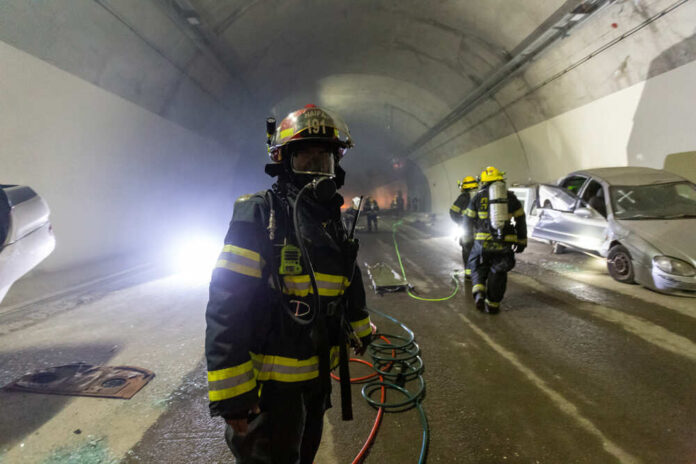
At least two dead in fiery Wyoming tunnel crash, as hazardous conditions hamper investigation
A catastrophic pileup in a Wyoming highway tunnel has left investigators grappling with a scene of destruction, hazardous chemicals, and structural instability. The incident, which occurred on Saturday in the westbound tunnel of Interstate-80 under Castle Rock in Green River, claimed at least two lives and left five others seriously injured. As authorities cautiously navigate the dangerous conditions, the full extent of the damage and the number of vehicles involved remain unclear, highlighting the complexity of this unfolding tragedy.
A Scene of Devastation and Danger
The crash site paints a grim picture of the incident’s severity. Photos reveal crumpled semitrailers outside the smoke-blackened tunnel entrance, while inside, the fire’s intensity has caused extensive damage to the concrete lining, resulting in falling debris. This combination of wreckage, smoke, and hazardous chemicals has created a treacherous environment for investigators, slowing their efforts to piece together the events leading to this disaster.
The magnitude of this incident cannot be overstated. The National Transportation Safety Board and highway patrol have launched a safety investigation, but the process is expected to be lengthy due to the complex and dangerous conditions. Officials have yet to determine the total number of vehicles involved, underscoring the chaotic nature of the pileup.
Investigators in Wyoming began sifting through the wreckage inside a highway tunnel on Saturday after smoke, hazardous chemicals and structural concerns prevented them from determining how many people may have died in the fiery pileup. https://t.co/dWM68g4jRP
— The Washington Times (@WashTimes) February 15, 2025
Impact on Traffic and Infrastructure
The crash has caused significant disruptions to interstate traffic, with vehicles being rerouted through Green River. While authorities work to clear the scene and assess the damage, travelers face unexpected delays and detours. The eastbound tunnel is projected to reopen in three days, allowing for two-way traffic, but the timeline for reopening the westbound tunnel remains uncertain.
This incident raises serious questions about tunnel safety and emergency response protocols. How could such a catastrophic pileup occur? Were there warning systems in place? And most importantly, how can we prevent similar tragedies in the future? As we await answers, it’s clear that a thorough examination of our infrastructure and safety measures is needed.
The Human Toll and Unanswered Questions
Beyond the physical destruction, the human cost of this tragedy is immeasurable. At least two families are mourning the loss of loved ones, while five others grapple with serious injuries. The psychological impact on survivors and first responders should not be overlooked, as they’ve witnessed a scene of horror that will likely stay with them for years to come.
As investigators slowly make their way through the wreckage, many questions remain unanswered. What caused the initial crash? Were hazardous materials being transported, and if so, were proper safety protocols followed? The answers to these questions could have far-reaching implications for transportation regulations and tunnel safety standards across the country.
At least two dead after fiery Wyoming tunnel crash https://t.co/lwS4b9egPC pic.twitter.com/VYjBUeCRPs
— New York Post (@nypost) February 15, 2025
A Call for Action
This devastating incident serves as a stark reminder of the potential dangers lurking on our highways. It’s high time for a comprehensive review of our transportation infrastructure, especially in high-risk areas like tunnels. We need to ensure that our roads are not just pathways for commerce and travel, but also safe corridors that protect the lives of those who use them.
As we await further details from the ongoing investigation, let’s not forget that behind every statistic is a human life. It’s our responsibility as a society to demand better safety measures, more robust emergency response systems, and stricter regulations for the transport of hazardous materials. Only then can we hope to prevent such tragic events from repeating themselves in the future.




















